How The Watch Industry Is Testing Blockchain And Cryptocurrency, Plus Five Brands That Have Already Waded In
Blockchain technology is just a digital trail of a transaction, a watch part – or anything really – that anyone can download and see and add to, but not delete any part of. Yet the two parties involved remain anonymous.
No one can rewrite the transaction history, nor will it ever disappear. Right away the benefit of anonymous transactions and tracking is apparent, if not yet mainstream in the timekeeping industry.
Cryptocurrency uses blockchain technology in its transactions. Bitcoin, Ethereum, XRP, Litecoin, and Facebook’s Libra are all cryptocurrencies. There are more than 1,000 cryptocurrencies in the market, but Bitcoin is by far the most used. However, Facebook with its worldwide reach and 2.4 billion customers could easily eclipse Bitcoin if it wished.
Each cryptocurrency works as a medium of exchange using blockchain cryptography to execute financial transactions. While the transactions are public, the counterparties remain anonymous as do the nature of their commerce.
That’s it. Nothing more complicated than that.
How does the watch industry use blockchain?
For starters, the watch industry suffers hugely from counterfeiters.
By attaching a unique Quick Response Code (QR for short) to a watch, then using blockchain to track its entire history from the beginning of the manufacturing process onward throughout its entire life, every step is permanently recorded. Steps can be added – such as services – but never deleted. This way, there’s no question whatsoever as to authenticity.
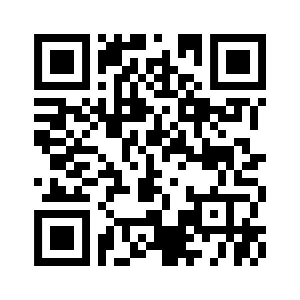
The author’s QR code
Richemont seems to be on the bleeding edge of employing blockchain. Among its many brands, it has chosen Vacheron Constantin – the world’s oldest continually operating watch manufacture – to test blockchain technology in tracking watches, beginning with its Les Collectionneurs line of vintage, pre-owned watches. If successful, the one-of-a-kind blockchain certification (which cannot be lost, stolen, or forged) could replace paper authentication.
Further, this indelible digital certificate of authenticity follows the watch throughout its life. The unique QR code and the particular movement and watch to which it is assigned are inseparable. This guarantees authentic data about the watch, its value, and authenticity.
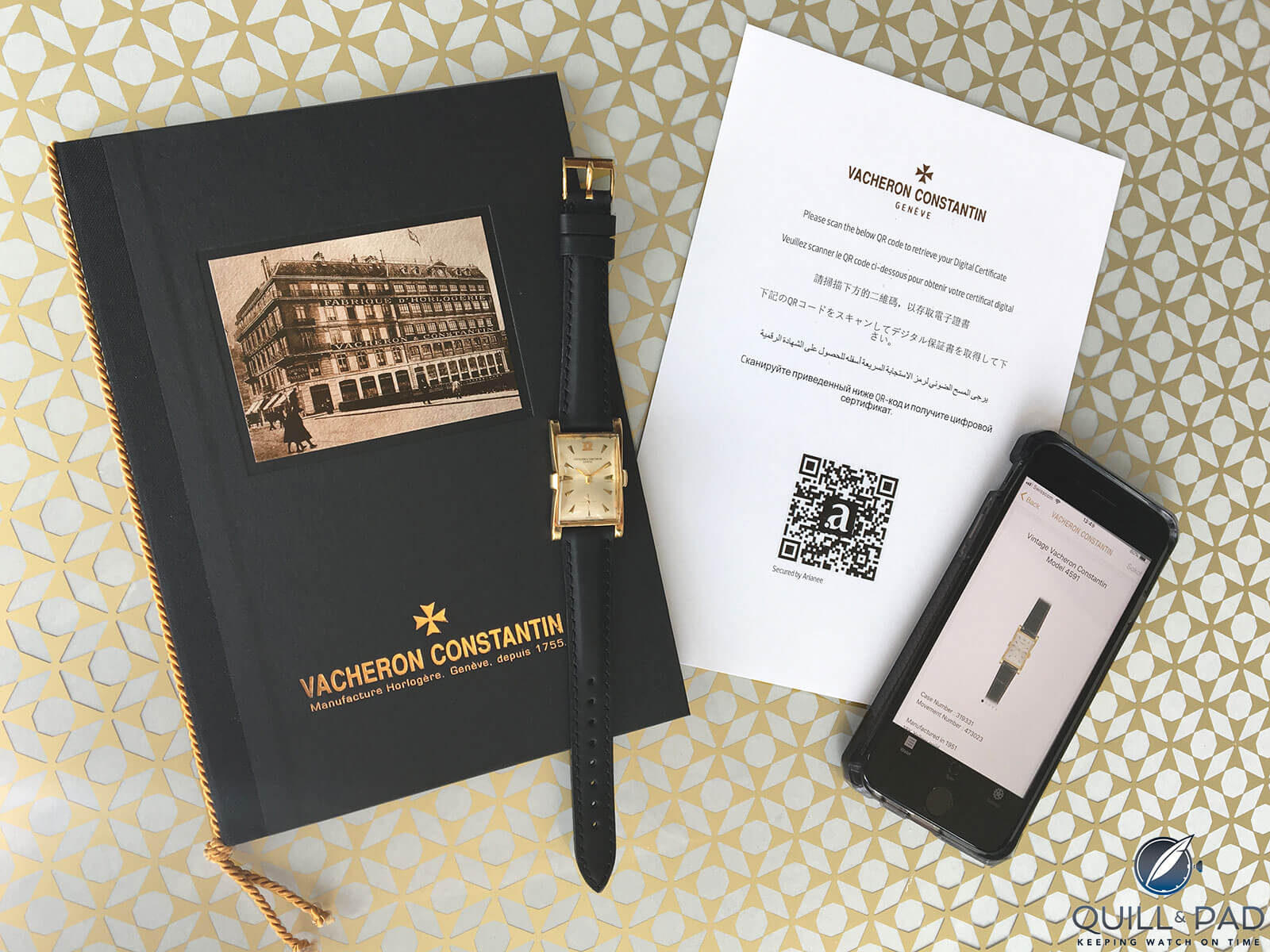
Vacheron Constantin blockchain technology for a pre-owned Les Collectionneurs timepiece
Using blockchain technology, the pre-owned and vintage markets instantly have a proven way to authenticate any watch with a unique QR code. This certainly won’t collapse the watch forgery industry – which seems to have its own place, however distasteful – but at least it prevents surreptitious bleed-over into the legitimate market.
Because scanning the QR code is so quick and easy (load any scan app onto your mobile phone, point the camera at the QRC, and it goes to the intended site), distinguishing an authentic watch from a fake could stabilize values in the secondary market, leaving only the watch’s condition, rarity, and perhaps its provenance as the differentiating factors to affect price.
Then there’s the grey market. The incorruptible blockchain can track the shipping progress of every new watch, from the brand in question to individual retailers and finally to the end consumer. It’ll flag any deviation to grey market operators.
Unique QR codes linked to a blockchain database could become the watch industry’s authentication standard in the next few years.
Who uses cryptocurrency and for what?
It has been said that Bitcoin is the millennial’s gold; that it’s a generational marriage between innovation and personal choice. That’s a huge stretch considering the nature of cryptocurrency transactions.
The most frequent use of cryptocurrency is for speculation – usually in Bitcoin. That isn’t buying or selling a commodity. Nor is it investing. Far from it.
Bitcoin is among the most volatile of any traded [dare I say?] currencies. Buying it in the hopes of cashing in on its appreciation is about as smart as grabbing a falling knife.
The second most frequent use of cryptocurrency is on the dark web – usually for illegal drug transactions. “Bitcoin is the most common form of payment for drug sales on dark net marketplaces and is emerging as the conveyance of choice for transferring illicit drug proceeds internationally,” the U.S. Drug Enforcement Agency wrote in its 2017 National Drug Threat Assessment.
The next most popular uses of cryptocurrencies – almost always in Bitcoin – are illegal money laundering, ransomware, and evading international sanctions. Indeed, North Korea’s currency of choice seems to be Bitcoin. Iran and Russia are fast following suit into cryptocurrency for the purpose of evading U.S. sanctions.
Add to these uses crypto theft and hacking the crypto infrastructure for fun and profit, and we’ve covered the lion’s share of cryptocurrency usage. The tiniest use category is legitimate transactions – such as buying a watch.
Watches that use Bitcoin: four brands lead the way
At least four prominent watch brands have hopped on the Bitcoin bandwagon, though: Franck Muller, Chronoswiss, A. Favre & Fils, and Hublot. Of these, Franck Muller seems to have the most robust cryptocurrency model.
Franck Muller Vanguard Encrypto
This high horology brand is famous for its unique designs beginning with its typical Cintrée Curvex case as well as fans among various Hollywood glitterati and top athletes. Franck Muller’s entry into the cryptocurrency space is its Vanguard Encrypto watch.
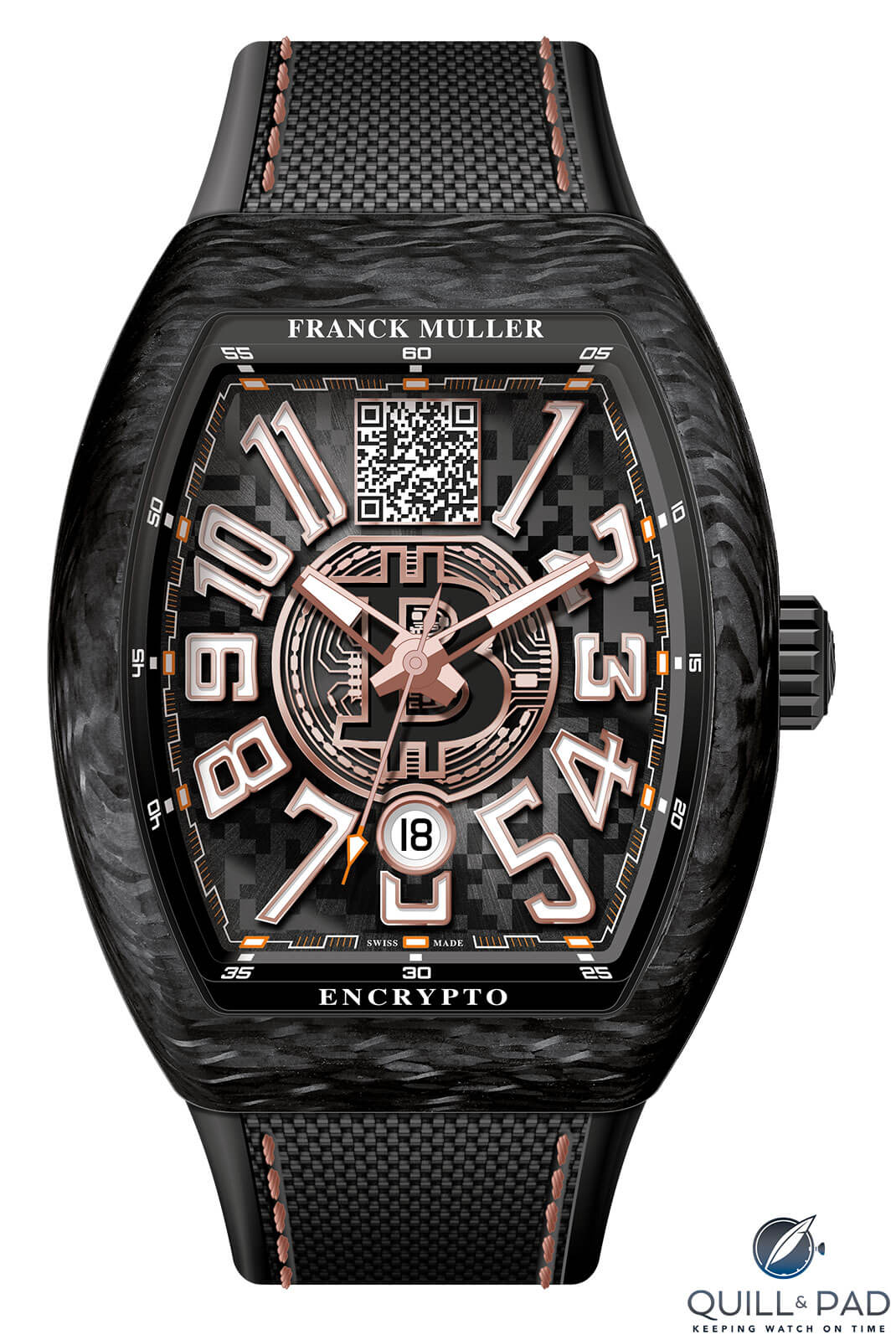
Franck Muller Vanguard Encrypto
The Vanguard Encrypto watch interacts with the owner’s Bitcoin wallet. Here’s how it works.
Each watch has its own unique QR code etched on the watch dial. That’s the public address for the owner’s personal Bitcoin wallet. Anyone can scan the QR code on the watch face and see the value of the Bitcoin wallet. The owner’s identity remains completely anonymous.
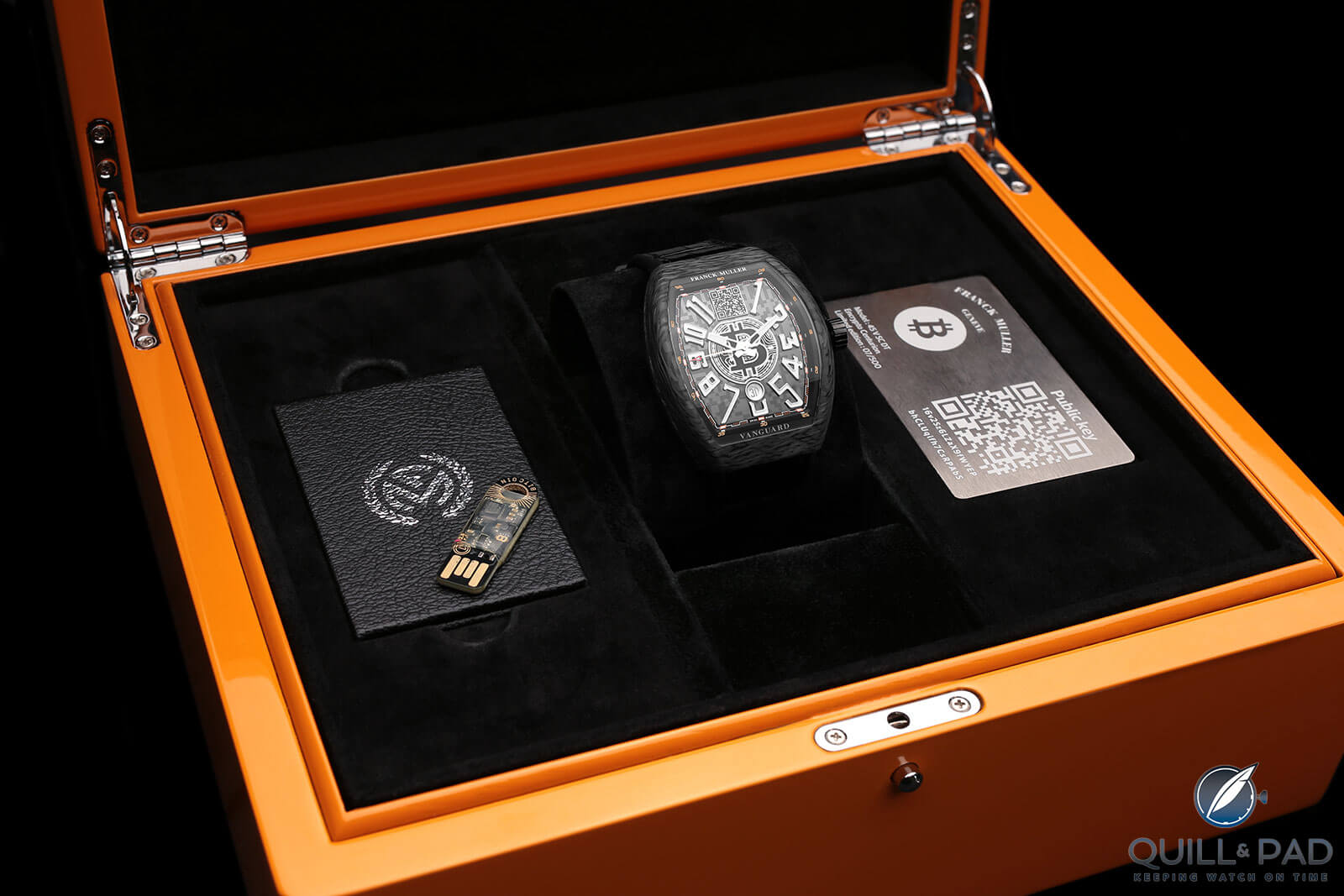
Franck Muller Vanguard Encrypto case and accessories
The second component in the Muller Encrypto package is a sealed USB device containing a private key code. The owner (or anyone with a clear view to scan the watch dial) can add Bitcoins to the owner’s wallet or check the balance.
However, removing Bitcoins from the wallet requires use of the USB device. For example, say Iran’s Hassan Rouhani wants to buy some nuclear centrifuges, U.S. sanctions notwithstanding. Rouhani just scans his Vanguard Encrypto watch to open the Islamic State’s Bitcoin wallet, then inserts his USB device into his laptop to verify access.
The required millions of Bitcoins instantly transfer to Vladimir Putin’s Bitcoin wallet. Transaction closed, and the centrifuges leave Novorossiysk for Bandar Abbas. Since the parties to this purchase are totally anonymous, the public sees only the flow of Bitcoins, not who paid or received them or for what purpose – a completely dark transaction.
And it’s far easier logistically than spending some of the $400 million in cash Barack Obama shipped to Rouhani in pallets aboard a cargo jet in 2016 in exchange for signing his nuclear treaty.
Franck Muller’s regional director Erol Baliyan says, “We always aim to impact the customer at an emotional level and create a bond between the customer and the timepiece. As a brand, we are a trend maker with a solid track record and are not shy when it comes to adopting innovation.”
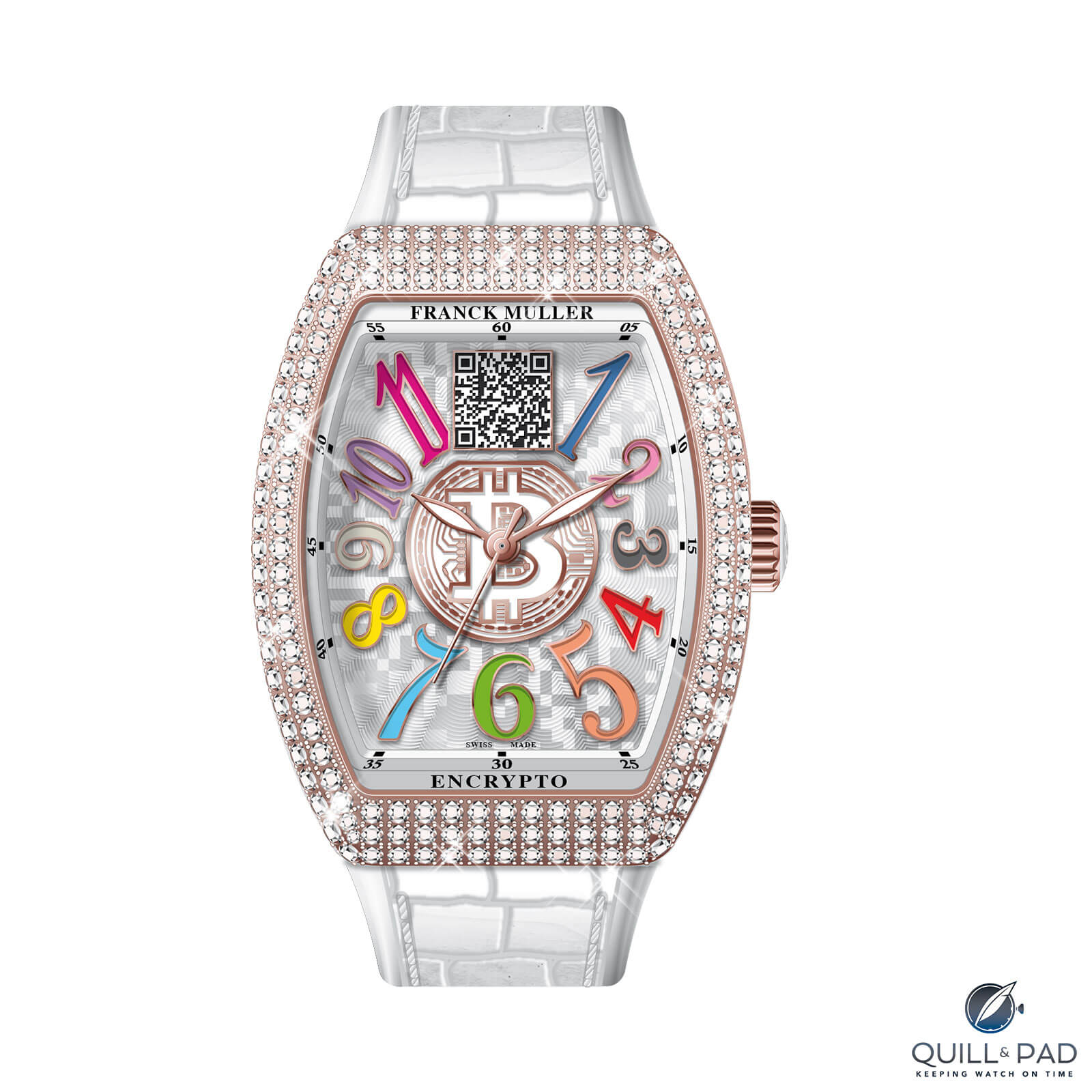
‘Crazy’ colorful gem-set Franck Muller Vanguard Encrypto
Franck Muller says the Encrypto watch is the first crypto-wearable. The Bitcoin logo sits front and center, right below the owner’s unique laser-etched QR code.
Buyers can order the case in a variety of metals as well as customize the dial with precious metals and diamonds. The cost for the watch ranges between $10,000 and $50,000 depending on case materials and diamond setting.
Deep cold storage features
Deep cold storage is simply cryptocurrency jargon describing how owners can keep a reserve of Bitcoins offline, protected from system failures and security breaches. It’s the digital cousin to a safety deposit box in a bank.
Franck Muller’s Vanguard Encrypto facilitates keeping a cache of Bitcoins in deep cold storage by using the two-piece authentication (the watch’s QR code on its face and the USB encrypted key). By the way, the USB device allows complete access (deposit or withdrawal) to the Bitcoin wallet and should be treated as cash. Franck Muller suggests it be kept in a highly secure, access-controlled location.
Each Franck Muller Encrypto timepiece is a two-piece set with its own unique public QRC address etched on the dial and a sealed USB device containing the private wallet access key. Owners can add Bitcoins to their virtual wallets or check their balances directly by scanning the watch dial.
To spend their Bitcoins, they need the USB key and a laptop.
Investing in Bitcoin
Editorial disclaimer: Bitcoin value is extraordinarily volatile (about six times that of the S&P 500). It moves on a daily basis in large swings for no apparent reason. It is not an investment vehicle, but rather an instrument of speculation. Perhaps that’s the reason Franck Muller designed this watch to be big and flashy with optional diamonds – exactly the watch a high-rolling cryptocurrency speculator would want strapped to his or her wrist.
Franck Muller designed the Vanguard Encrypto’s QR code and cold storage system in partnership with Regal Assets, an alternative asset investment company with corporate headquarters in Waco, Texas.
I could not verify Regal Assets or its CEO, Tyler Gallagher, as being registered with the Financial Industry Regulatory Authority or the SEC. Unregistered firms are not subject to the rules, regulations, or oversight governing licensed U.S. broker/dealers and registered investment advisers.
Regal Assets touts Bitcoin as an alternative investment for IRA accounts (see editorial disclaimer above). IRAs buying Bitcoin is an exercise requiring several steps. First, you need to establish a self-directed IRA if you don’t already have one. You’ll also need to establish an IRA LLC.
The LLC will be the entity buying and selling Bitcoin for the IRA account. Honestly, I wasn’t able to figure out how to use the Encrypto watch and USB key to buy and sell Bitcoin for an IRA account. There’s probably a way, but it escaped me.
One more thing about investing in Bitcoin for your IRA: you cannot transfer any Bitcoins you now own directly into your IRA LLC. You must first sell it, transfer the dollars into your IRA LLC, then buy back the Bitcoins for benefit of your IRA account. The same procedure follows for a Roth IRA.
The Vanguard Encrypto is a limited-edition watch of just 500 units of each version available online. Franck Muller accepts credit cards, bank transfers, or payment in Bitcoin. It is available both online and at the Franck Muller boutique in the Dubai Mall.
Chronoswiss gently enters the Bitcoin market
Chronoswiss, founded in Munich in 1983 and now under Swiss ownership, hopes to up its cool index by slipping into Bitcoin’s updraft. The company will produce just 100 Flying Regulator Open Gear Blockchain watches, and it already accepts payment for watches ordered in its online webshop in Bitcoin and other cryptocurrencies.
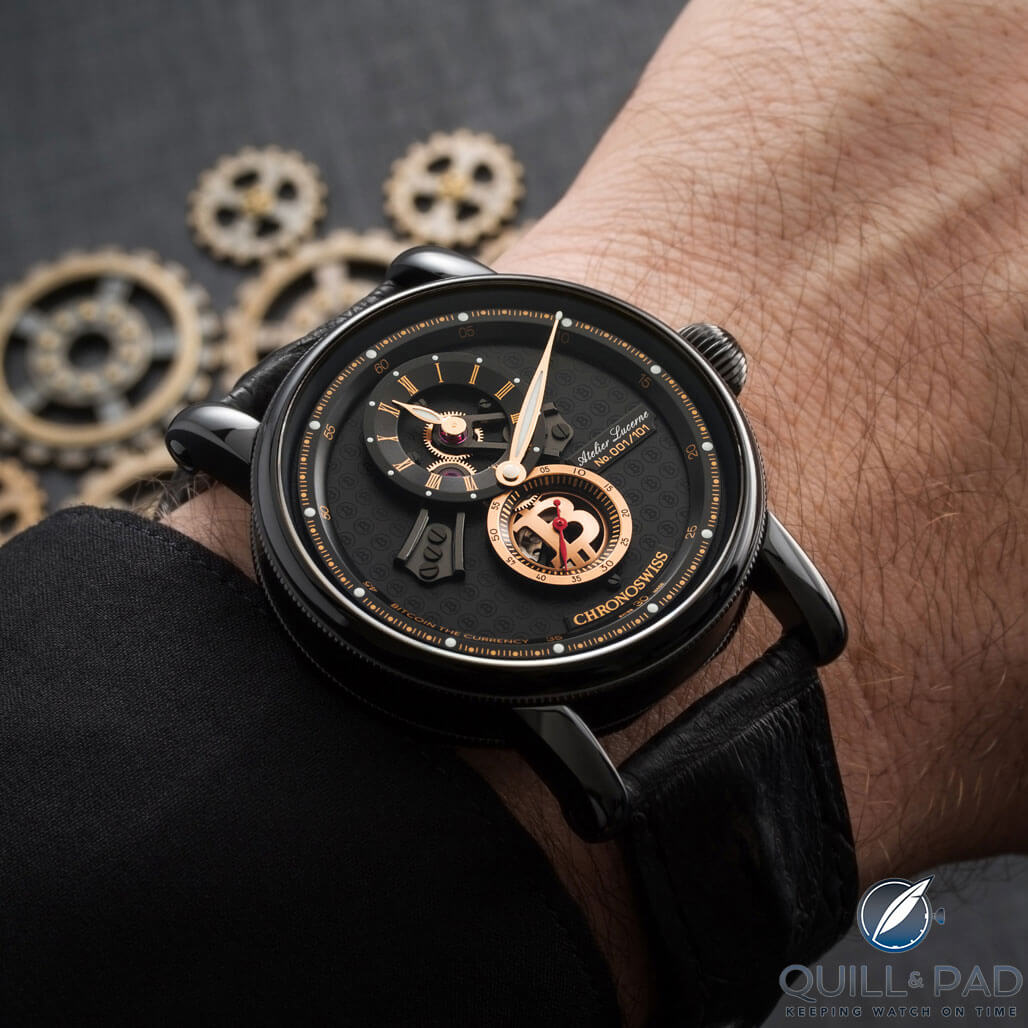
Chronoswiss Flying Regulator Open Gear Blockchain
The three-dimensional regulator-style dial’s top level boasts very mechanical-looking funnel-like subdial frames for displays of hours and seconds together with obvious, skeletonized bridges bracing some visible gear wheels.
The dial’s bottom level features a galvanic black background with multi-logo print of Bitcoin along with the Bitcoin logo inside the subdial for the seconds.
This is a beautifully crafted watch. Chronoswiss’ Caliber C.299, which is based on an automatic ETA movement with hacking seconds and a modified regulator gear train, hums along inside the 16-piece stainless steel case coated with black DLC. The strap is equally high-end in hand-sewn black hornback crocodile. The price is 8,356.55 Swiss francs.
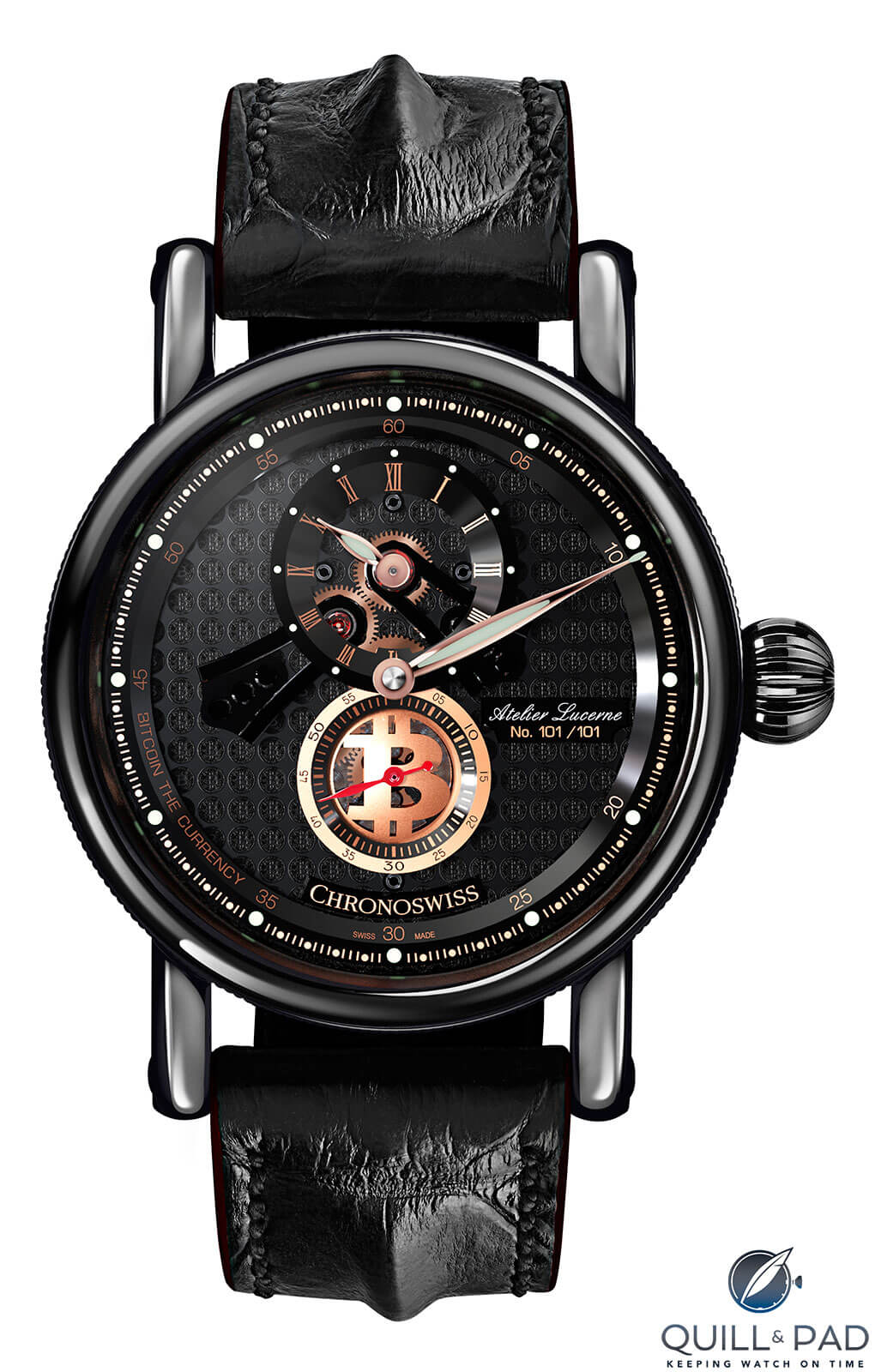
Chronoswiss Flying Regulator Open Gear Blockchain
Though this Chronoswiss watch model is not interactive with Bitcoin (the logo references to Bitcoin being just for show), the guarantee certificate that comes with it uses blockchain technology.
The company has a relationship with Tech Bureau, a fintech and cryptocurrency company in Japan, the U.S., and Europe. Tech Bureau has developed Mijin, a private blockchain software, and Zaif, a Bitcoin and cryptocurrency exchange platform. With this strategic relationship, there may well be a future Chronoswiss watch offering that actually uses blockchain and/or Bitcoin technology.
A. Favre & Fils
A. Favre & Fils has offered Swiss watches off and on for something like three centuries, beginning with a certain Abraham Favre, who found a calling in watchmaking in 1718. A 2008 refounding of the firm was actuated by 46-year-old Laurent Favre.
The Swiss firm just announced it is developing a handcrafted mechanical timepiece with a built-in crypto cold wallet and a proprietary security solution using blockchain technology.
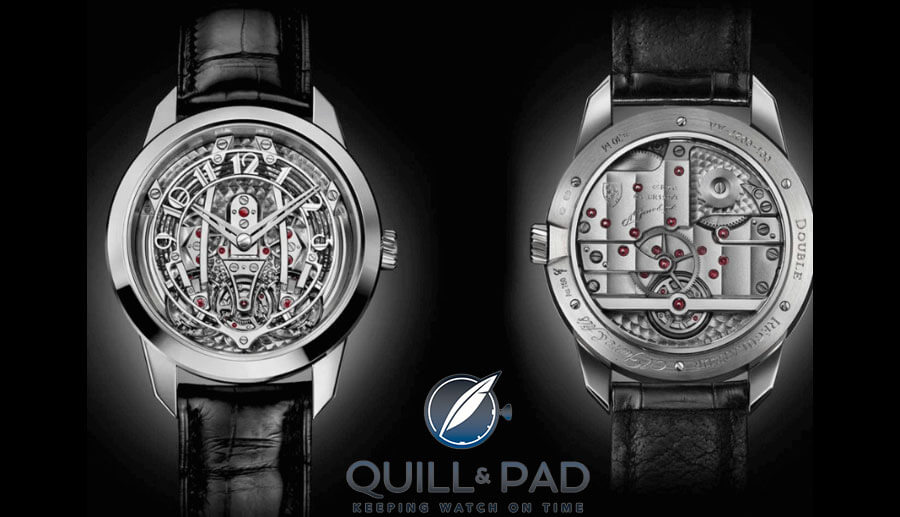
The recently announced, but not yet seen, Bitcoin watch by A. Favre & Fils
The new watch was scheduled for release before the end of June 2019 according to a press release, but none of the Quill & Pad team has seen it yet. The company’s press release says the watch will, “guarantee [the] ultimate in data security and privacy protection.”
The price is quoted as $102,000 – $153,000. No price quote in Bitcoin since the conversion rate moves so fast.
Unfortunately, the company hasn’t offered any further details on how the crypto wallet works. The image above was shown as a teaser without authentication of it being the final design of the new blockchain watch. We’ll have to wait and see.
Hublot
Hublot seems to be proceeding cautiously into the Bitcoin world with a first step being the 210-piece limited edition Big Bang MECA-10 P2P (peer-to-peer, the type of payment enabled by Bitcoin). Why the 210-piece limit? It’s a reference to the maximum global limit of 21 million Bitcoins.
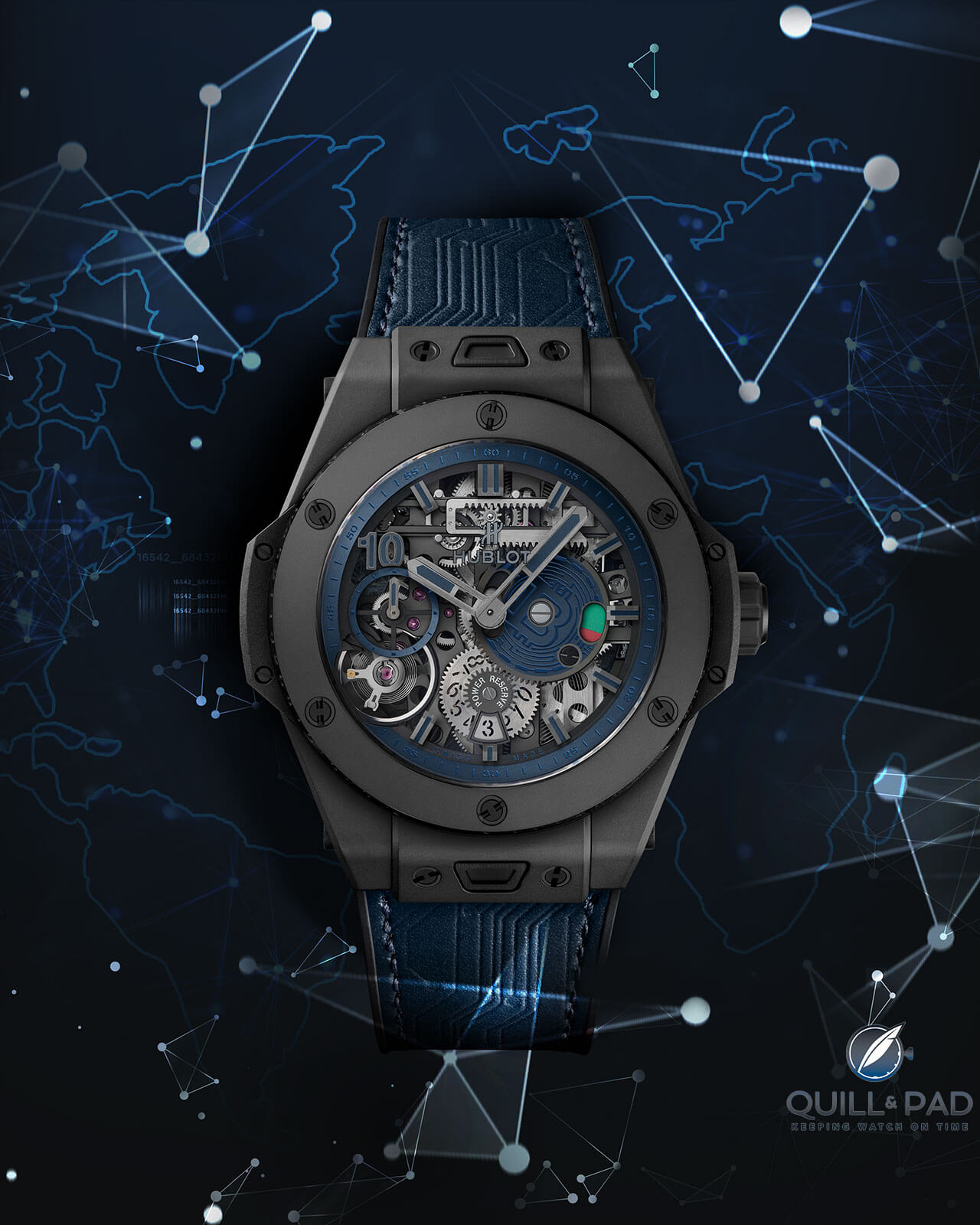
Hublot Big Bang MECA-10 P2P
The watch can only be purchased online and paid for using Bitcoins. It does not interact with blockchain nor offer any sort of offline deep cold storage wallet oozing Bitcoins. However, it does have the transaction number engraved on the bezel edge.
This, coupled with the purchase exclusively using Bitcoins, produces an indelible blockchain record. It serves as a digital verification of authenticity rather than a traditional and less reliable serial number appearing on a paper sales receipt and warranty card.
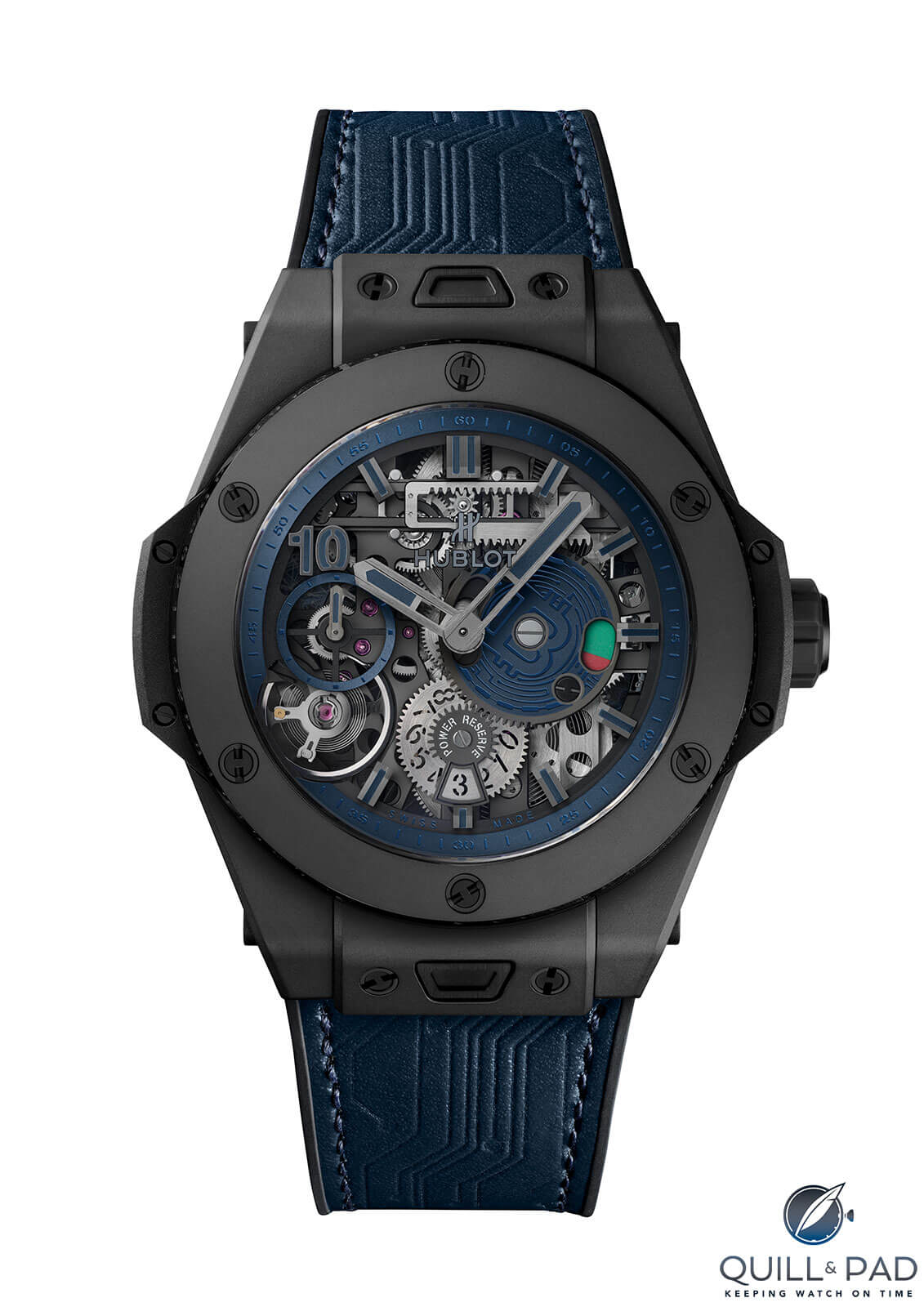
Hublot Big Bang MECA-10 P2P
Hublot’s MECA-10 line carries the brand’s Big Bang “DNA.” It is big, sporting a 45 x 15.95 mm case made of microblasted black ceramic. The skeletonized HUB1201 manually wound movement has a power reserve of ten days (would be nice if that were in honor of Bitcoin’s tenth anniversary, but this astonishingly long serial power reserve is represented by the “10” in the “MECA-10” line) that is shown on the 6 o’clock subdial. The Bitcoin logo appears at the 3 o’clock position.
A true nod to Bitcoin’s anniversary comes from the only Arabic numeral hour marker on the dial: the 10.
The unique case back shows an engraved world map upon which blue dots connect throughout the various countries depicted. This is a reference to the world’s interconnectivity fostered by blockchain and using Bitcoin as the international currency of choice. The MECA-10 is water resistant to 100 meters and comes only in black microblasted ceramic with blue elements.
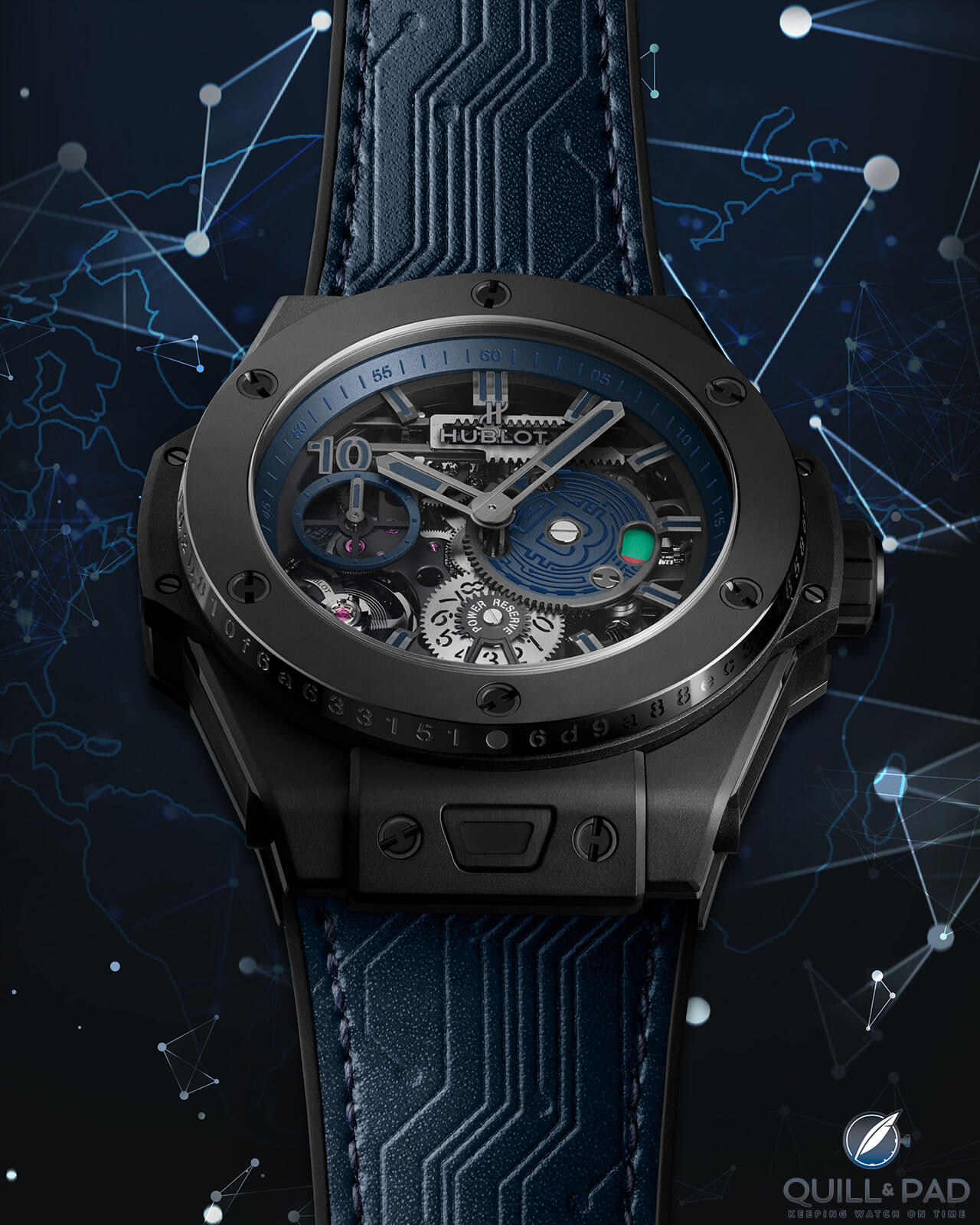
Hublot Big Bang Meca-10 P2P
The rubber-and-calfskin strap boasts an embossed circuit board design as an homage to blockchain, networks, and interconnected computers.
The cost of this latest piece from Hublot – paid in Bitcoins, whose value fluctuates by the second – is approximately the equivalent of $25,000.
Quick Facts Franck Muller Vanguard Encrypto
Case: 45 mm or 38 mm; choice of stainless steel, brushed titanium, carbon fiber, polished pink gold, diamond setting; case back is engraved with Bitcoin logo
Dial: diamond-set Bitcoin logo, diamond-set circuit board pattern, or no diamonds; QR code at 12 o’clock
Movement: automatic Caliber FM 0800 (ETA base), with 42-hour power reserve, 4 Hz/28,800 vph frequency
Functions: hours, minutes, seconds; date (45 mm version), Bitcoin/blockchain functionality
Price: $10,780-$55,880 (45 mm version), $9,800-$38,500 (38 mm version)
More information: www.franckmullerencrypto.com
Quick Facts Chronoswiss Flying Regulator Open Gear Blockchain Series
Case: 41 x 13.85 mm, DLC-coated stainless steel
Movement: automatic Caliber C.299 (ETA base), with 42-hour power reserve, 4 Hz/28,800 vph frequency
Functions: hours, minutes, hacking seconds (regulator style)
Limitation: 101 pieces
Price: 8,356.55 Swiss francs
More information: www.blockchainseries.ch
Quick Facts Hublot Big Bang MECA-10 P2P
Case: 45 x 15.95 mm, black ceramic
Movement: manually wound Caliber HUB1201, with 10-day power reserve, 4 Hz/28,800 vph frequency
Functions: hours, minutes, seconds; power reserve indication, power reserve warning indicator
Limitation: 210 pieces
Price: €23,800
More information: www.hublot.com/en/collection/big-bang/big-bang-meca-10-p2p-45mm
You may also enjoy:
Navigating The Grey Market: A Retail Expert Explains The Whys And Wherefores
Hublot Big Bang MECA-10: A Shift In Consciousness
My Trip Back To The Beginning And Watch Mecca: Franck Muller Vanguard Gravity
Trackbacks & Pingbacks
-
[…] Source link […]
Leave a Reply
Want to join the discussion?Feel free to contribute!



wow! nice article!! Cryptocurrency and Blockchain will make the fantafabulous products. Thanks for Sharing.
My experience is that noollow links do have a very important place in the SEO game so getting loads of noollow links via commenting can make a significant difference in ranking especially for new site that has great content. But there is one thing I am not sure of, How much do the comments actually add up to the content of a site ? I mean are the comments included in site content like rest of the article or do the search engines treat it differently and do not include it in the content of the post!